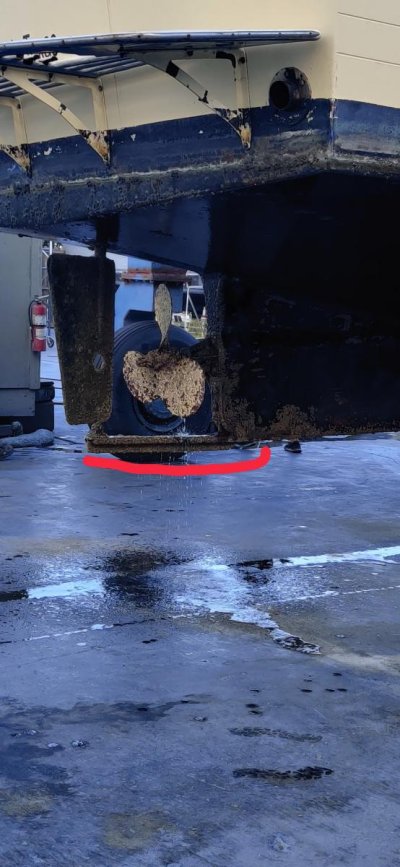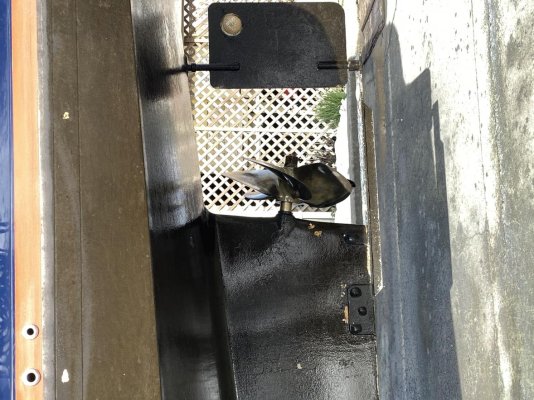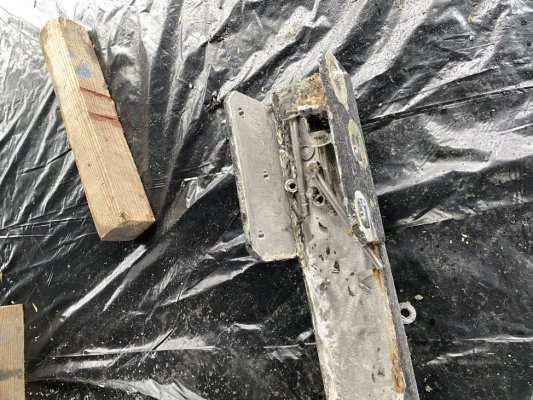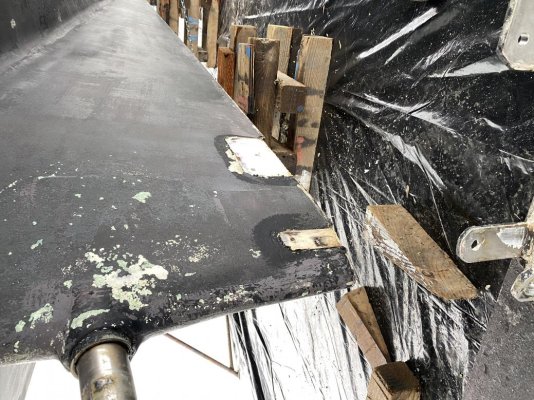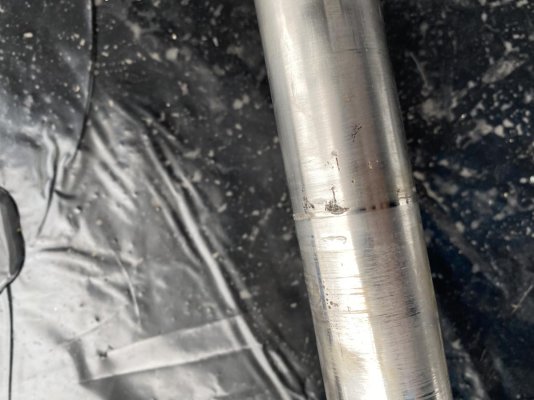You are using an out of date browser. It may not display this or other websites correctly.
You should upgrade or use an alternative browser.
You should upgrade or use an alternative browser.
Rudder shaft? Help
- Thread starter Tuesday86
- Start date
The friendliest place on the web for anyone who enjoys boating.
If you have answers, please help by responding to the unanswered posts.
If you have answers, please help by responding to the unanswered posts.
Stout
Senior Member
A good prop shop that also repairs or makes new prop shafts can rebuild it for you. We had ours done last year after it was pulled for maintenance and crevice corrosion was found on the shaft where the rudder shaft seal contacted the shaft and was leaking.
Comodave
Moderator Emeritus
- Joined
- Jul 2, 2015
- Messages
- 21,330
- Location
- Au Gres, MI
- Vessel Name
- Black Dog
- Vessel Make
- Formula 41PC
I have heard it referred to as a rudder shoe.
Rudder shaft is the vertical pivot for the rudder.I have heard it referred to as a rudder shoe.
I've seen rudder shoe as Dave stated or also "sand shoe"
Mostly Horizontal bar from keel to bottom of rudder shaft.
Comodave
Moderator Emeritus
- Joined
- Jul 2, 2015
- Messages
- 21,330
- Location
- Au Gres, MI
- Vessel Name
- Black Dog
- Vessel Make
- Formula 41PC
I was looking at the red drawing in the photo. He said rudder shaft but drew the red line that is more like a shoe.
It’s called a skeg and you have a skeg hung rudder. Stainless in my opinion is a poor choice for this application as you note in your post. It sort of looks like the skeg is bent up but it could be a photo illusion. Anyway on glass hulls like yours the aft lower portion of the keel is an envelope or void often filled with left over resin sometimes with foam and capped off with mat and resin. Either way access to this area and the skeg bolts is almost impossible and therefore a big problem. If skeg bolts are SS then I suspect crevice corrosion is probably at play. I would certainly unship the rudder and see if the skeg has any movement a sure sign of fastener problems. If the builder glassed over the skeg in way of the keel it may still feel firm but a glass overlay is insufficient by itself to support the rudder or any light grounding loads. A bent skeg will force the base bearing up hard on the lower rudder stock and can even upset the rudder port alignment and linkages making for hard if not frozen steering and potential damage
While the rudder is dropped I would look hard at the upper rudder stock in way of the rudder port for pitting and wastage. Now is the time to correct anything else going on. You can’t ever take chances with your steering gear. When I was working in the boatyards if we ran into a skeg problem that required replacement or re-bolting we generally cut out an access hole hoping to get at the bolts. Most of the time they were buried in resin mish-mash so we’d spend hours chiseling out clearance for wrenches. Then patch the keel, paint and nobody was the wiser. If you had more vertical between the hull and rudder I would suggest a four bolt rudder stock palm so removing the rudder down the road is a piece of cake. But you don’t.
If the rudder stock is badly corroded and a new skeg required I’d head to a work boat steel fab shop. It’s not such a big deal to weld repair. Do Not accept a patched up rudder stock of multiple sections — no butt welds. When repairs are done hang the rudder and clamp it so it won’t drop. Align the skeg and a new base bearing and make sure the base bearing which is usually just a bushing, Cutless bearing or high density Delrin like plastic is correct size for the rudder size and loads. If you’re running in thin water where you’re kick up sand a Cutless bearing may be best except lignum vitae but good luck finding that wood. Regardless of material you do not what anywhere close to a tight fit between the base bearing ID and stock as the rudder and your steering system needs some play to turn easily. If the rudder has to go to the fab shop you may want to consider flaring the trailing edge about 3° to improve performance. The shop can weld tabs easily on the edge and you’ll have a sharper turning rudder with much better slow speed performance. Plus it’s easier on your linkage since a flare rudder will not generally vibrate in prop wash.
BTW I would not buy into a new skeg designed with vertical side plates and cross bolting. I’ve seen a number of glass hulls torn open from ground accidents with this type of skeg.
Good luck
Rick
While the rudder is dropped I would look hard at the upper rudder stock in way of the rudder port for pitting and wastage. Now is the time to correct anything else going on. You can’t ever take chances with your steering gear. When I was working in the boatyards if we ran into a skeg problem that required replacement or re-bolting we generally cut out an access hole hoping to get at the bolts. Most of the time they were buried in resin mish-mash so we’d spend hours chiseling out clearance for wrenches. Then patch the keel, paint and nobody was the wiser. If you had more vertical between the hull and rudder I would suggest a four bolt rudder stock palm so removing the rudder down the road is a piece of cake. But you don’t.
If the rudder stock is badly corroded and a new skeg required I’d head to a work boat steel fab shop. It’s not such a big deal to weld repair. Do Not accept a patched up rudder stock of multiple sections — no butt welds. When repairs are done hang the rudder and clamp it so it won’t drop. Align the skeg and a new base bearing and make sure the base bearing which is usually just a bushing, Cutless bearing or high density Delrin like plastic is correct size for the rudder size and loads. If you’re running in thin water where you’re kick up sand a Cutless bearing may be best except lignum vitae but good luck finding that wood. Regardless of material you do not what anywhere close to a tight fit between the base bearing ID and stock as the rudder and your steering system needs some play to turn easily. If the rudder has to go to the fab shop you may want to consider flaring the trailing edge about 3° to improve performance. The shop can weld tabs easily on the edge and you’ll have a sharper turning rudder with much better slow speed performance. Plus it’s easier on your linkage since a flare rudder will not generally vibrate in prop wash.
BTW I would not buy into a new skeg designed with vertical side plates and cross bolting. I’ve seen a number of glass hulls torn open from ground accidents with this type of skeg.
Good luck
Rick
Stout
Senior Member
Rudder shoe
Tuesday: attached are some pix of our rudder shoe during maintenance. We did this as preventive maintenance on the bolts that connect the shoe to the keel. Ours was an all SS fabrication original to the 2008 boat. FYI, the SS bolts were in perfect condition.
Tuesday: attached are some pix of our rudder shoe during maintenance. We did this as preventive maintenance on the bolts that connect the shoe to the keel. Ours was an all SS fabrication original to the 2008 boat. FYI, the SS bolts were in perfect condition.
Attachments
Comodave
Moderator Emeritus
- Joined
- Jul 2, 2015
- Messages
- 21,330
- Location
- Au Gres, MI
- Vessel Name
- Black Dog
- Vessel Make
- Formula 41PC
I would use new 316 S/S bolts even if the old ones look good. Crevice corrosion is hard to see with the naked eye until it starts to crack. We had a bow eye on a previous boat break under load from the trailer winch. It had looked fine but when it broke we could see where the crevice corrosion had gone about 3/4 of the way through the eye. The cost of new bolts is insignificant compared to the amount of labor that went into the job.
Stout those bolts in the middle photo did you use them again or replace them ?. Though the photo details aren’t the best it sure looks like one or two of those bolts show pitting from crevice corrosion. Using any stainless bolt or fastener underwater is a crap shoot. You may be lucky and there is enough free oxygen in your boats location to maintain a passive surface on the bolts surface ( chrome in alloy ) but where water flow and oxygen are deprived then all bets are off.
Got and better shots of those bolts
Rick
Got and better shots of those bolts
Rick
I would use new 316 S/S bolts even if the old ones look good. Crevice corrosion is hard to see with the naked eye until it starts to crack. We had a bow eye on a previous boat break under load from the trailer winch. It had looked fine but when it broke we could see where the crevice corrosion had gone about 3/4 of the way through the eye.
It’s actually almost rare to find crevice corrosion internally only. As the passive later breaks down stainless ( any 300 alloy ) becomes regular old steel and the corrosive progress attacks on a granular level almost alway showing various patterns of pitting and most of the time, depending on alloy, a color change since the passive chromium shine has been breached. I have boxes of crevice corrosion samples I used in USCG classes years ago in New London and I don’t think any are undetectable on the surface provided you can get to the surface. Using special focused probes and my UT equipment I shot thousands of bolts, shafts etc for Lloyds, most major underwriters including the USN & Coast Guard and this equipment and methods are very reliable
Rick
Garbler- thanks for the very detailed info. All info is greatly appreciated. The bolts were definitely not reusable, I should have posted a pic of those things! They were worn almost through and through in the points that went through the boat. There were absolutely no zincs on the boat when we hauled her out. Like I said, the previous owner did a horrible job at maintaining her.
Stout
Senior Member
Rick, all of the bolts looked brand new. We did replace the SS nylock nuts. They were bedded with epoxy. I had expected them to be corroded after 12 years. Now the rudder shaft had corrosion at the shaft seal location and below. We had to replace it.
Attachments
Rick, all of the bolts looked brand new. We did replace the SS nylock nuts. They were bedded with epoxy. I had expected them to be corroded after 12 years. Now the rudder shaft had corrosion at the shaft seal location and below. We had to replace it.
That’s good news then. The photos may have tricked me.
Rick
I have always called that part a sand shoe, or rudder skeg.
Buck Algonquin, who calls them “skeg bars”, makes them available in a variety of lengths and widths made of bronze.
Available from DeepBlueYachtSupply or others who handle Buck Algonquin.
Buck Algonquin, who calls them “skeg bars”, makes them available in a variety of lengths and widths made of bronze.
Available from DeepBlueYachtSupply or others who handle Buck Algonquin.
Similar threads
- Replies
- 51
- Views
- 5K

